Disclaimer: Our content doesn't constitute medical or fitness advice. We may be earning money from companies & products we review. Learn more
Oh, the infamous kettlebell Turkish get-up! It’s probably the most complained-about exercise I teach, but once the technique is drilled and practiced (as with most movements), it quickly becomes the fan favorite.
Why wouldn’t it be? It is the most variable, challenging, strength building, and conditioning exercise the kettlebell has to offer. It’s also one of the oldest! In other words, it’s really the best, and this has been proven for centuries since it first originated in Tsarist Russia.
Can you tell I’m a fan? You can warm up with it, use it as your whole workout or finish off any strength or conditioning set.
Kettlebell Turkish get-ups engage multiple muscle groups simultaneously and ask you to stabilize a weight overhead as you rise from a supine position. The sequentially moving series of positions is methodical and strategic to make sure you are stacking joint over joint and giving your body the best chance it has to stand up with a weight overhead.
If it’s done well, you are able to stand up with a weight that you’d most likely never be able to press. If you miss a step, you’ll most likely cap out with a small weight and feel uncomfortable. But don’t let this discourage you, the gains are worth it! And although it takes practice, it pays off in spades.
Table of Contents
- 1 Why Perform the Kettlebell Turkish Get-up?
- 2 The Kettlebell Turkish Get-Up: Step by Step
- 3 Key Tips for Performing Kettlebell Turkish Get-ups
- 4 Common Issues With Kettlebell Turkish Get-ups
- 5 Remedies for Kettlebell Turkish Get-ups
- 6 Muscle Groups Targeted by Turkish Get-ups
- 7 Benefits of Turkish Get-ups
- 8 Choosing the Right Weight
- 9 Fun Historical Nugget on Turkish Get-up Exercises
- 10 Try Turkish Get-ups Today With A One-on-One Consult
Why Perform the Kettlebell Turkish Get-up?
In the get-up, the entire body is activated, including the core, shoulders, glues, quads, triceps, and all surrounding stabilizing muscles, making it a literal total body movement.
What’s really great is more than the strength gains, it also improves proprioception and body awareness. It requires full focus and coordination, making it a valuable addition to any training regimen and at any age.
Especially as my clients get older, being able to get up from the floor is the most functional thing they can master. I’ve been teaching it for over a decade and will most likely never take it out of my practice, personally or professionally.
As with any intricate movement, mastering the Turkish get-up takes practice and patience.
The Kettlebell Turkish Get-Up: Step by Step
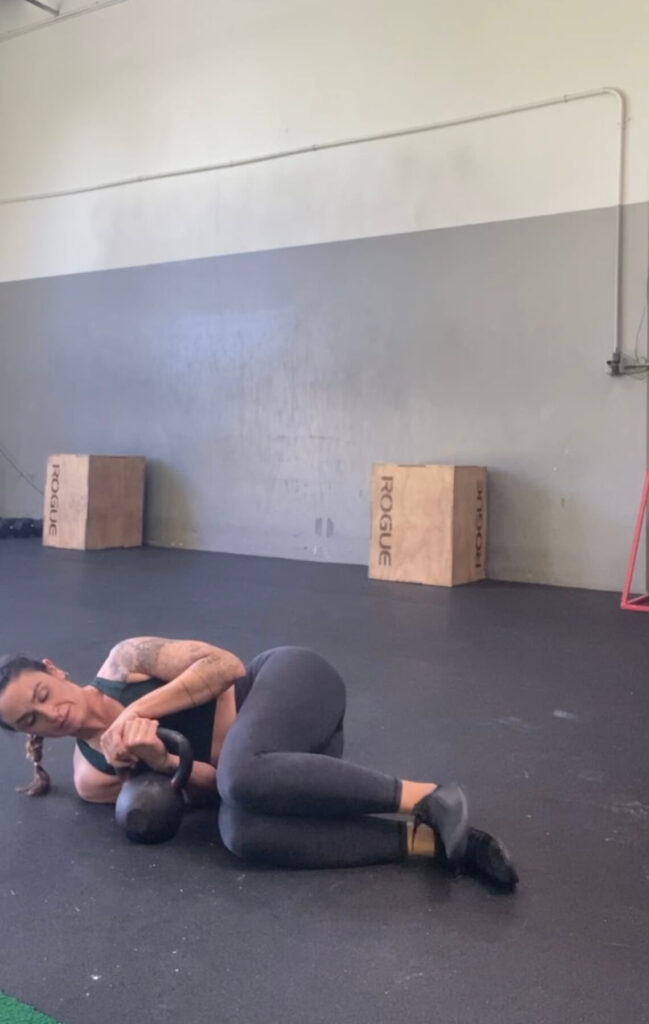
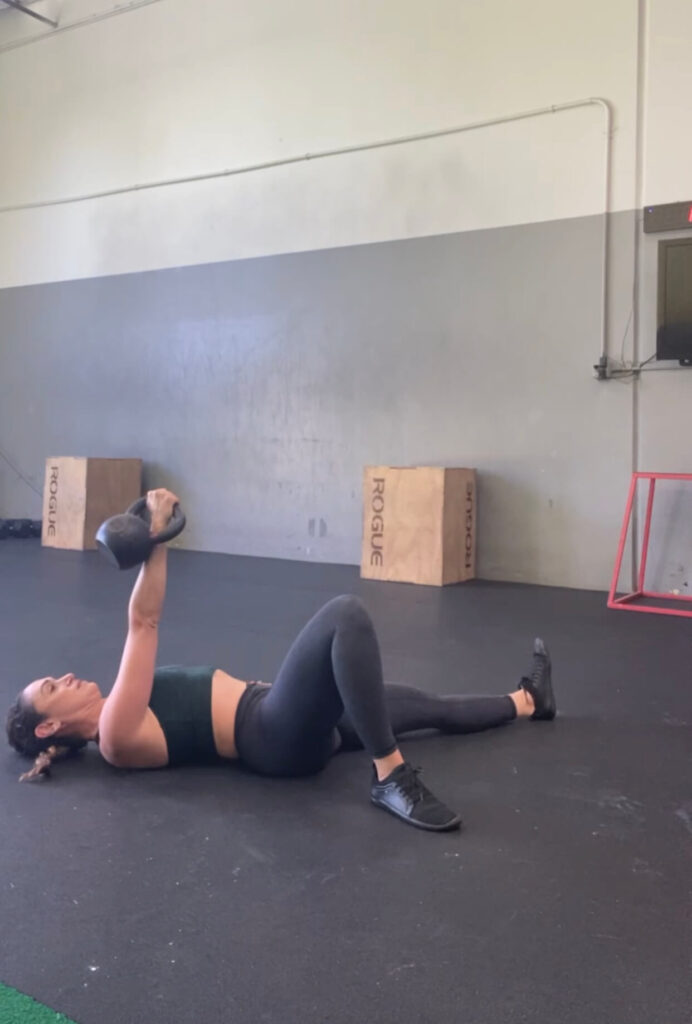
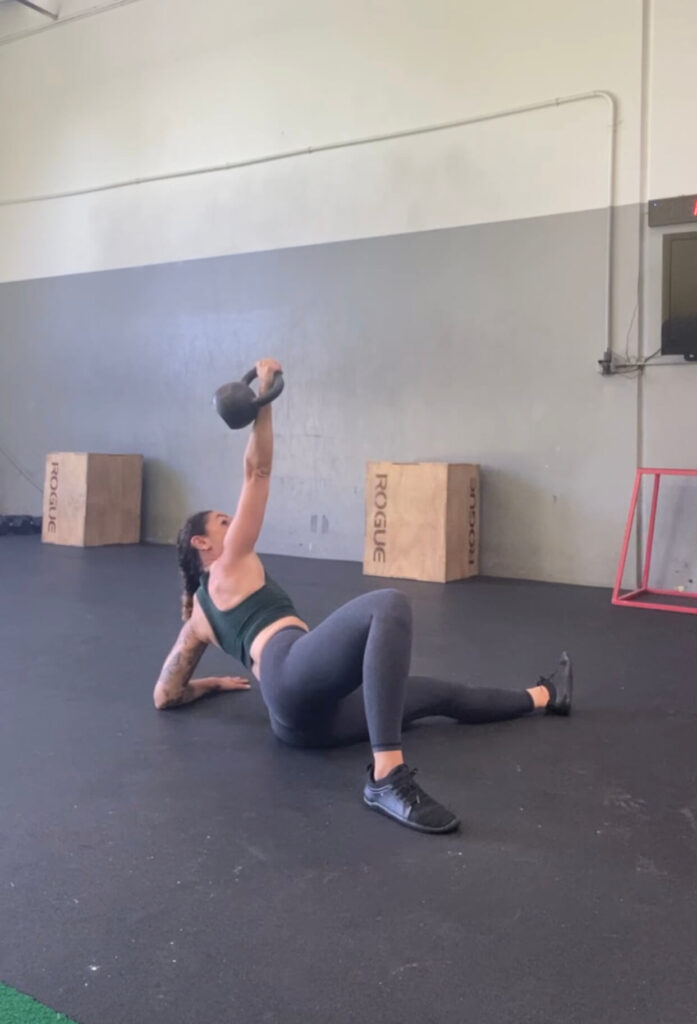
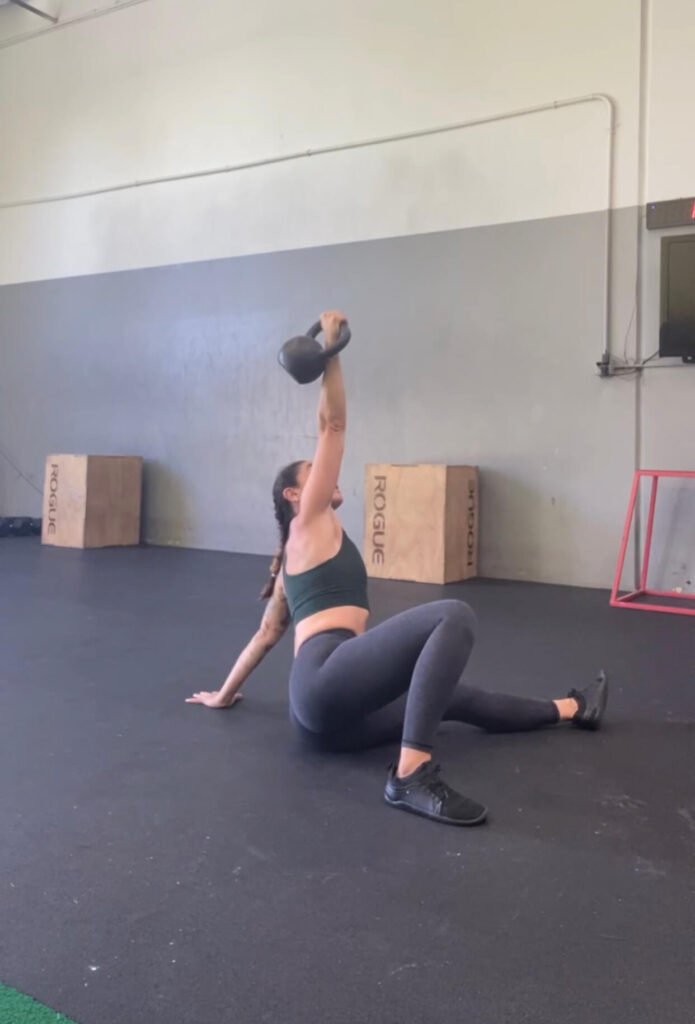

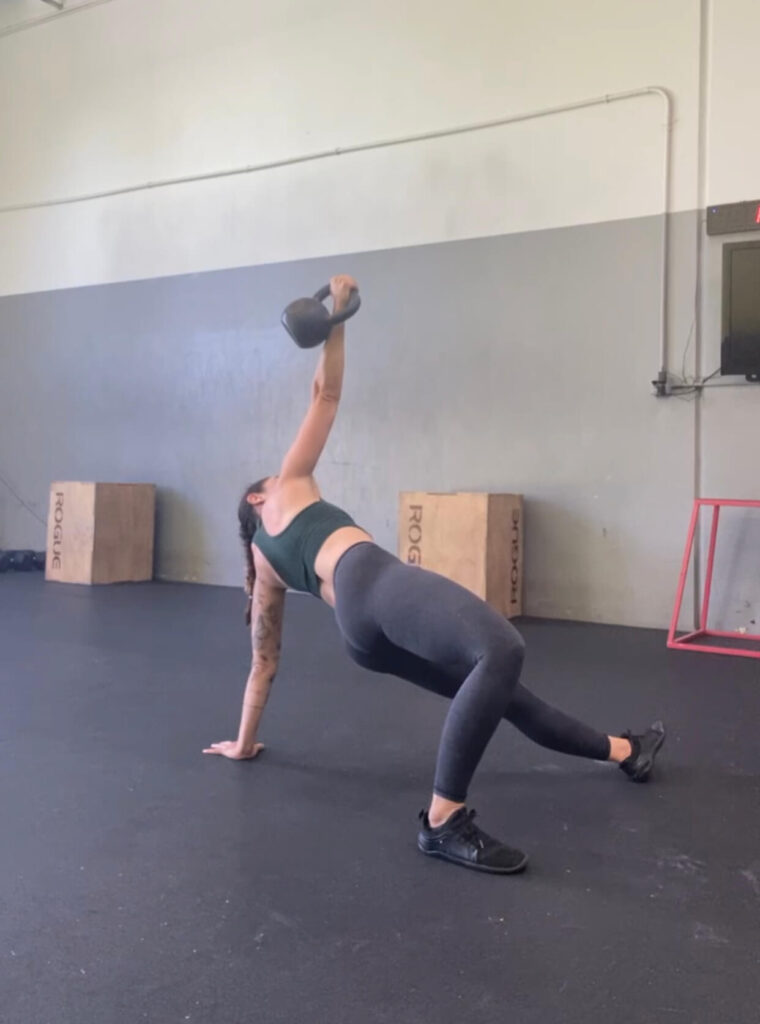
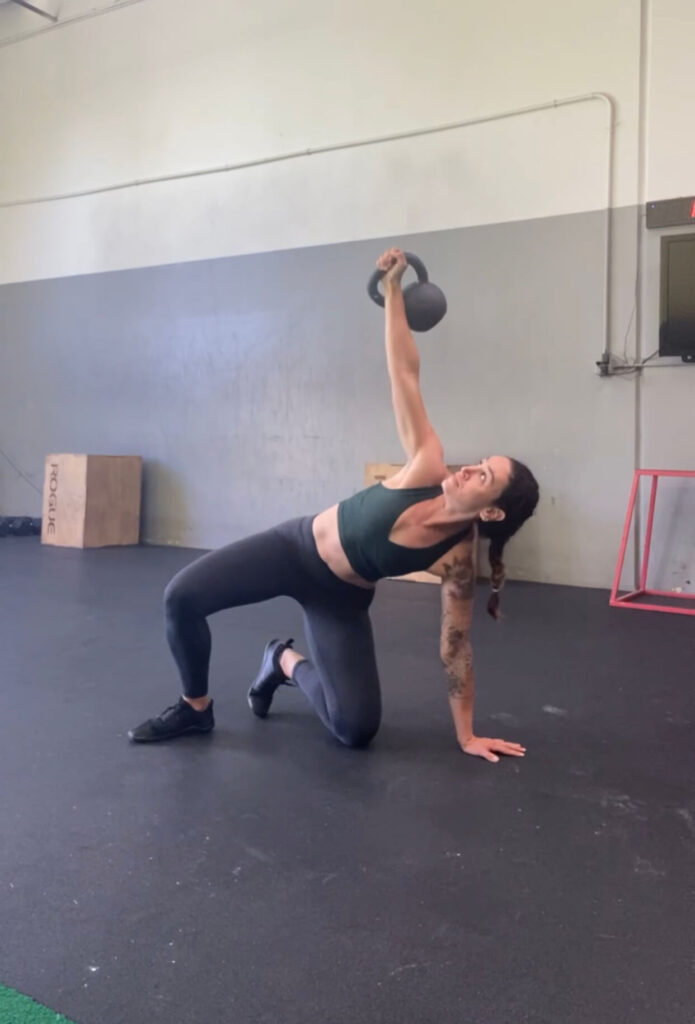

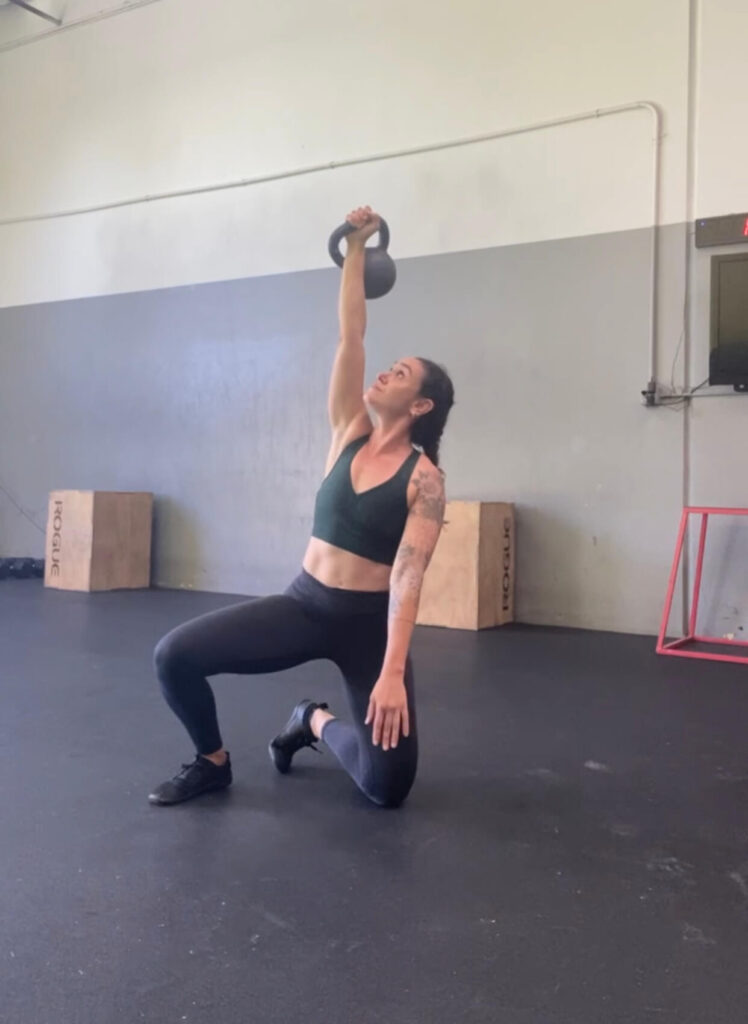
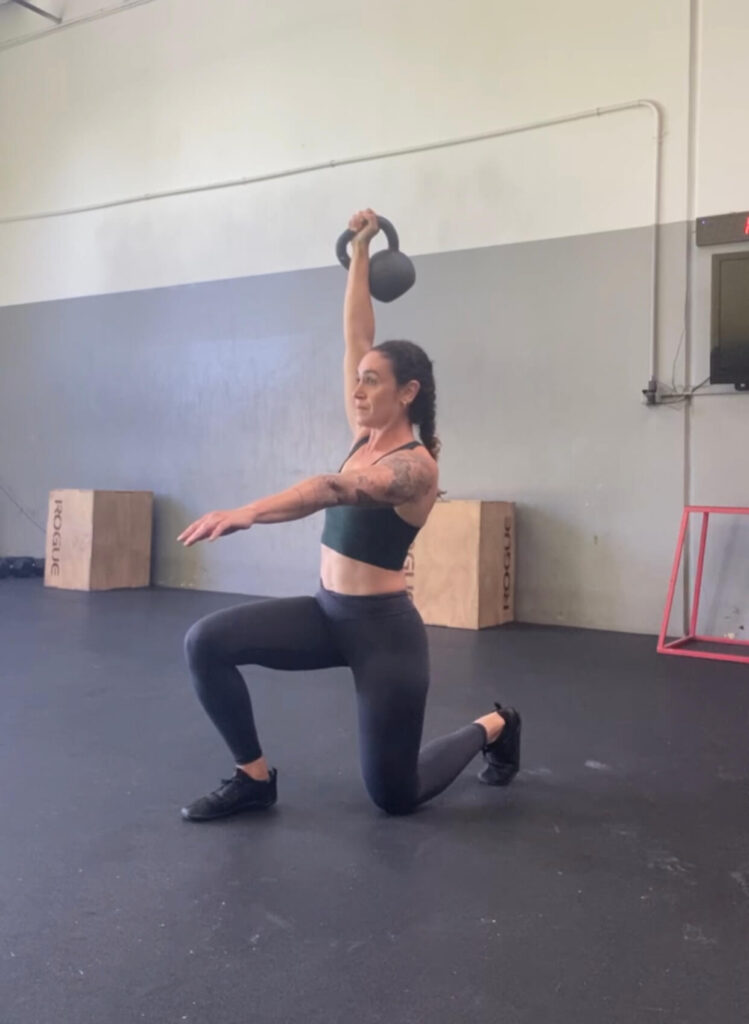

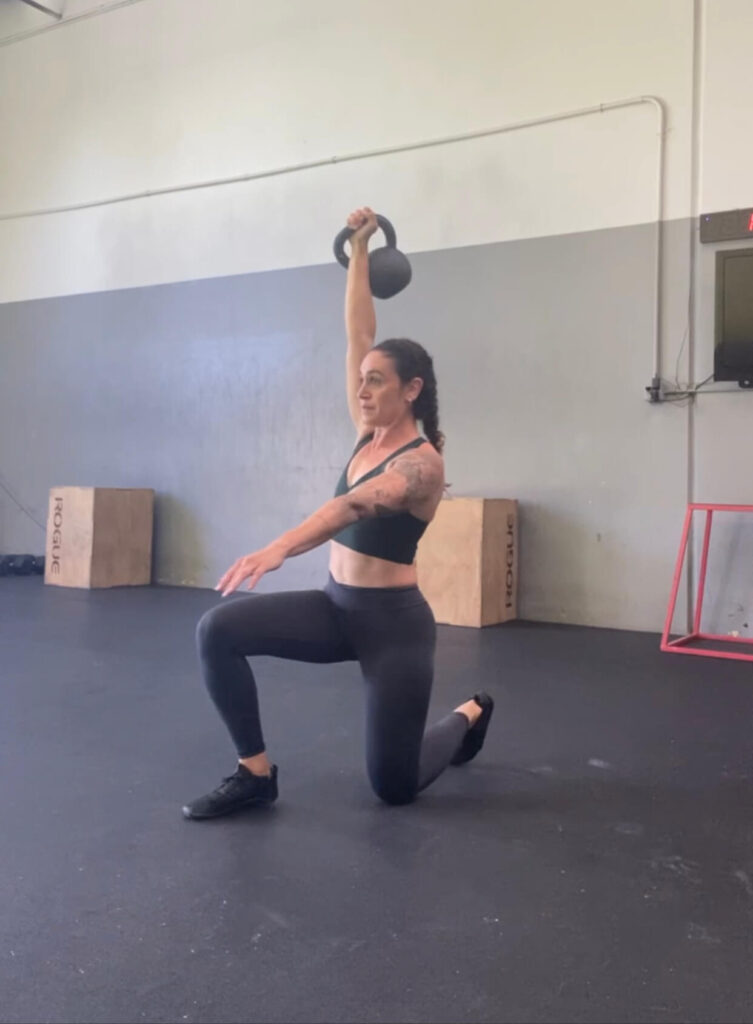
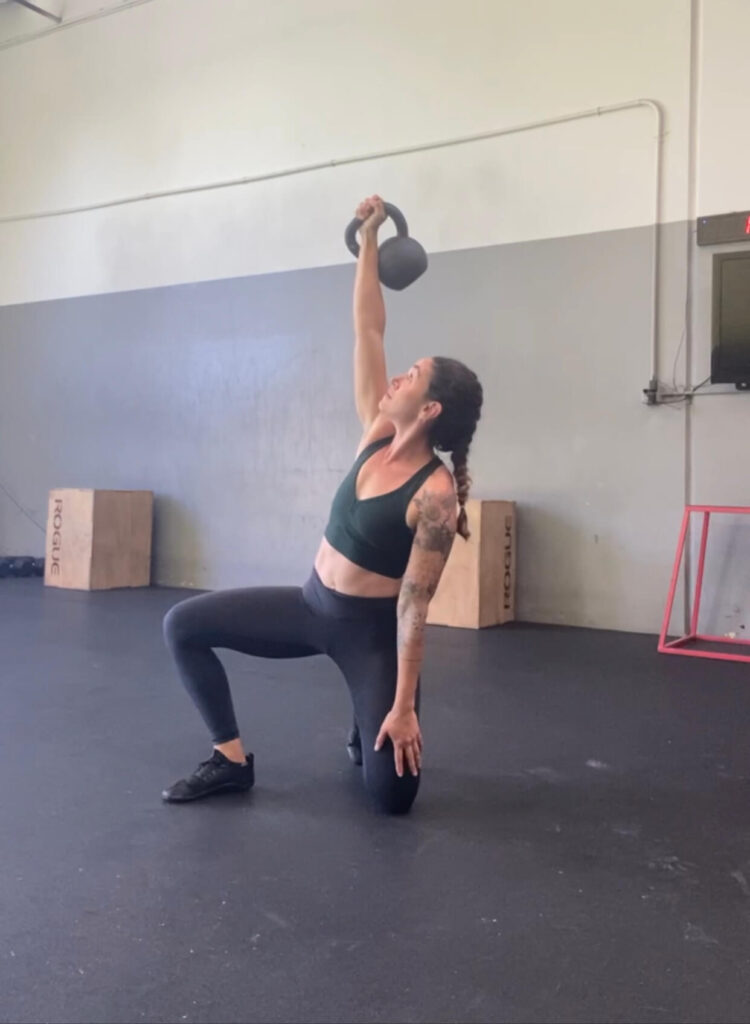
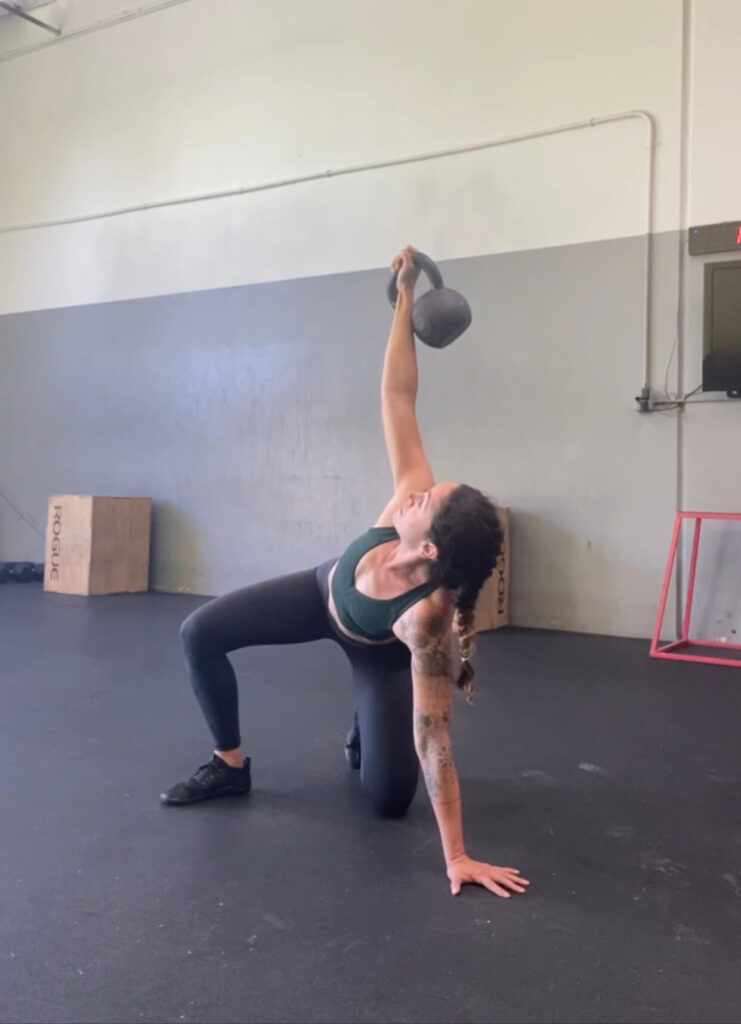
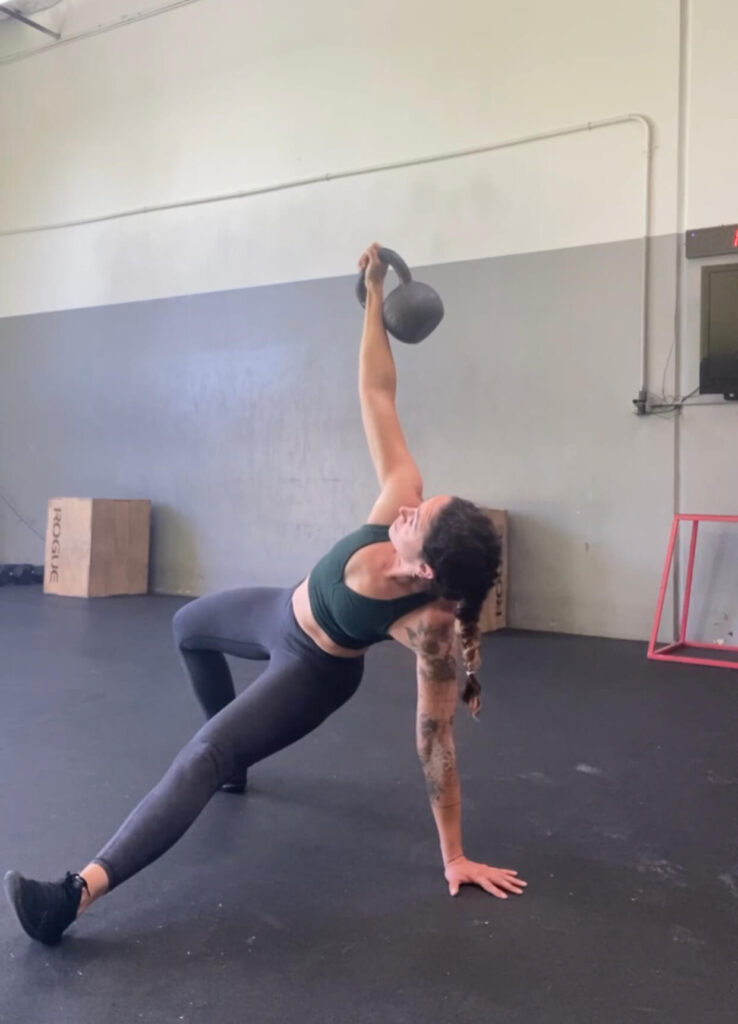
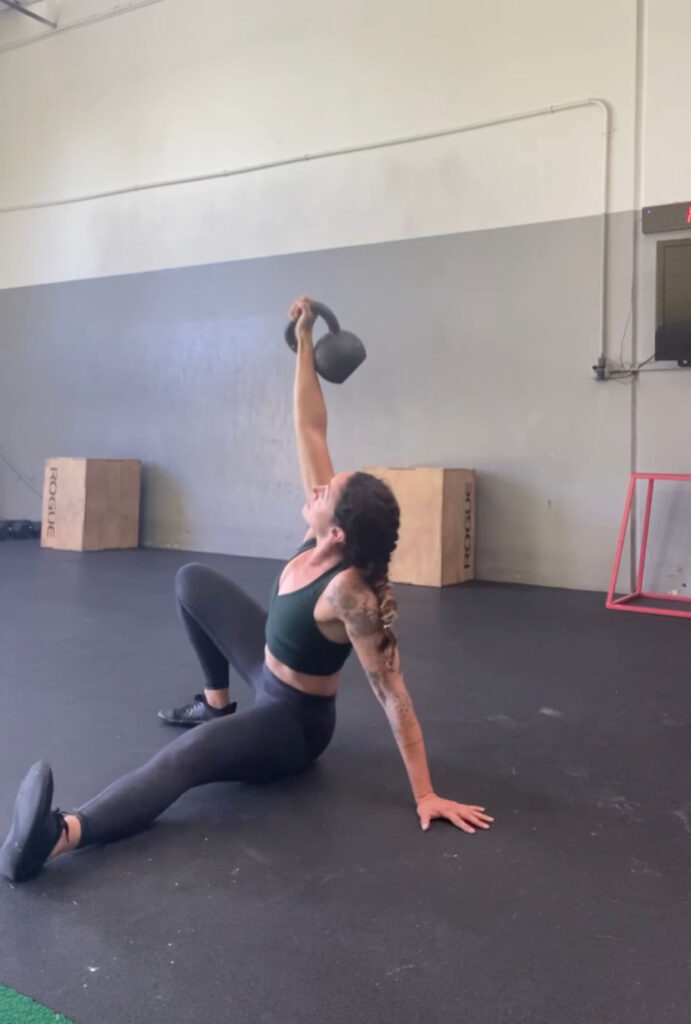
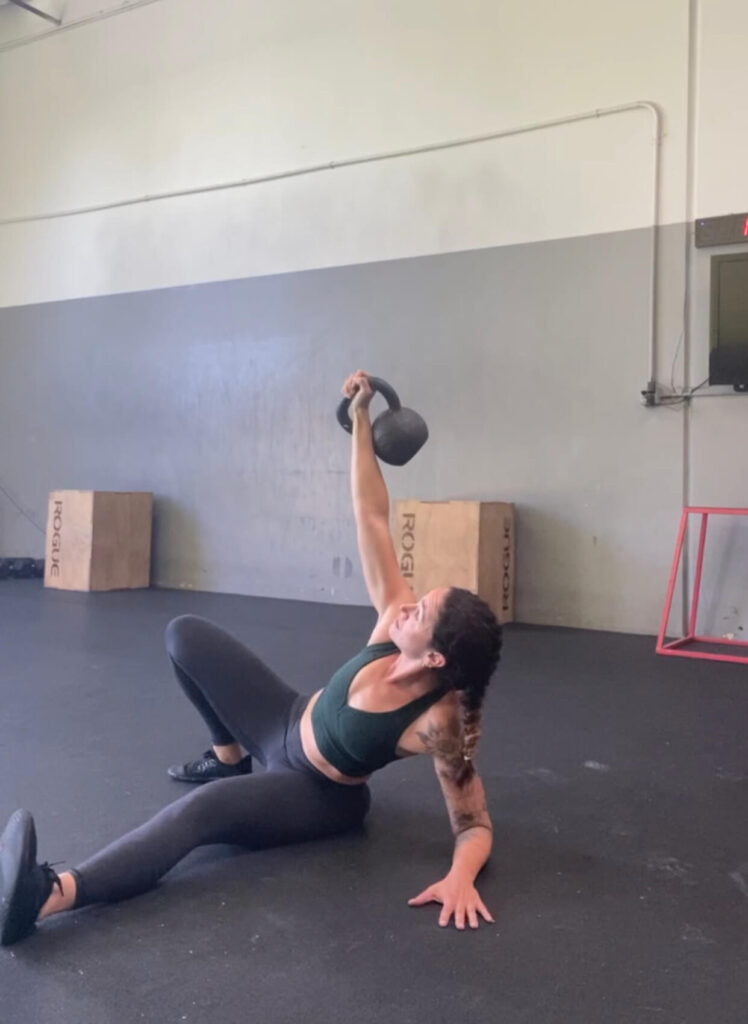
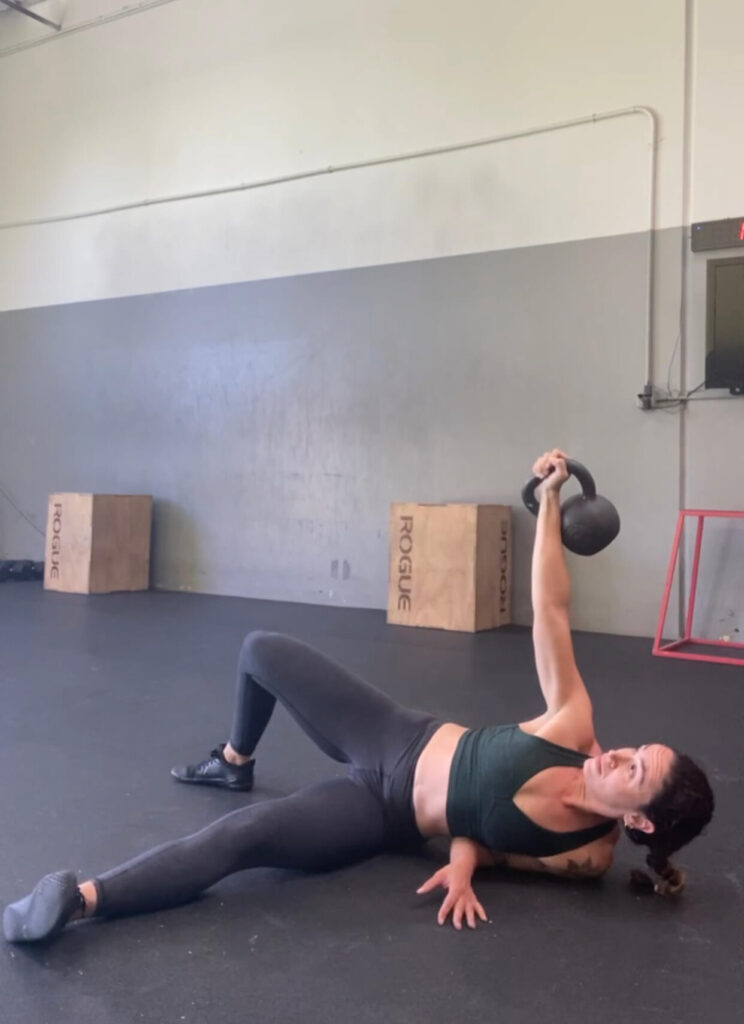
- Starting Position:
Begin by lying on your back on the floor, with your right knee bent and right foot flat on the ground. Your left leg and left arm should be extended at a 45-degree angle from your body, and your right arm should be extended overhead, holding the kettlebell in hand. Make sure your knuckles are pointing toward the ceiling when holding the kettlebell. This is a huge part of stacking your joints. Your eyes are officially locked to your kettlebell until you are fully standing.
- Roll to the Elbow:
Roll onto your left side and prop yourself up on your left elbow. You can use your hand and palm to grip the floor and pull yourself to this position with one big exhale. The knee on the right side should not go inward towards your midline, press into the foot to keep it straight. The kettlebell should be positioned directly above your shoulder.
- Lift to Hand:
Pull through your left hand to lift your torso off the ground, coming up onto your left hand.
- Bridge to Hips:
Lift your hips off the ground by driving through both of your feet. Your weight should be on your left hand and the bottom of your left foot, creating a straight line from your hand to your foot.
- Sweep Left Leg:
Slide your left leg back and underneath your body, replacing where your buttcheek was with your foot, positioning it in a “L” position. You’re building your foundation here. Your right foot remains flat on the ground. Make sure to properly align your right heel and your left toes.
- Lift to Kneeling Position:
Sit back into your right hip and lift your hand off the floor to a kneeling position. The kettlebell should still be held with your bicep close to your ear overhead in your right hand.
- Set Up Your Lunge:
You have a choice here! You can either rotate your left shin to line up with your right leg and into a kneeling position OR you can step your right leg 90 degrees to line up with your back leg. Think “I’m setting up the best lunge position possible to stand up.”
- Stand Up:
From the kneeling position, press into your right foot to stand up, keeping the kettlebell overhead and pulling your left foot towards your right. Your core should be engaged, and you should maintain a stable position throughout the movement. Here and only here can your eyes come off the kettlebell and look straight ahead.
- Reverse the Movements:
- To return to the starting position, reverse the movements. Your eyes go back up to the kettlebell when you’re ready to lunge back and start the descent.
- Step back with your left foot into a lunge.
- Rotate the back knee or move the front leg to line up with the back in a “L” position.
- Find your thigh with your left hand and use it to go slowly lower your hand to the floor then out away from your knee.
- Place your palm down, you should be creating a three legged box with your hands and legs.
- Extend your left leg forward and dig your heel into the floor while lifting your hips into the same bridge position you had while going up.
- Place your hips down on the floor and carefully lower your torso back down to your elbow then shoulder and then roll on to your back.
- Repeat on the Other Side:
After completing the Turkish get-up on one side, lay down with your kettlebell in the fetal position, grab onto the handles and pull it in a semi circle over your head to the other side. Go back into the fetal position to start, placing your hand into the grip and pushing the kettlebell overhead while rolling onto your back to begin.
Key Tips for Performing Kettlebell Turkish Get-ups
- Keep your eye on the kettlebell throughout the entire movement.
- Maintain a straight line from the kettlebell to your hand, through your body, and down to your foot in the bridge position. Your arm should never break the chain, you accomplish that by never bending at the wrist or elbow.
- Control each movement, and focus on stability and balance. Go slower than you think you should.
- Remember, the Turkish get-up is a complex exercise that requires practice. You can break down each portion and practice them individually and then string them together as a way to build strength in each position.
Common Issues With Kettlebell Turkish Get-ups
Rushing the Movement: Moving too quickly through the get-up can compromise stability.
Inadequate Core Engagement: Insufficient core engagement may lead to instability during the transitions.
Skipping Steps: As the kettlebell becomes heavier, it’s far harder to be successful if you skip steps. Don’t skip the steps, take them one at a time.
“Breaking the Chain”: if you break the chain of stacked joints, you lose power. Make sure to start from the top and go all the way down. Knuckles over wrist, wrist over elbow, elbow over shoulder, shoulder over hip, hip over knee and knee over ankle.
Remedies for Kettlebell Turkish Get-ups
Slow and Controlled: Perform the Turkish get-up slowly, focusing on each transition.
Core Activation: Prioritize core engagement throughout the entire movement.
Active forearms: Knuckles toward the ceiling means your forearms are active and pushing the kettlebell towards the ceiling.
Muscle Groups Targeted by Turkish Get-ups
- Core
- Shoulders
- Quads/Glutes
- Stabilizing muscles throughout the body
Benefits of Turkish Get-ups
- Improves overall strength and stability
- Enhances proprioception and body awareness
- Engages multiple muscle groups simultaneously
- Demands full attention and focus
Choosing the Right Weight
Start with no weight! Master the movement, then use a shoe and stabilize it on your knuckles. Can you keep it there while you do the full movement? The trick is to never take your eye off the shoe! Once you master that, a light kettlebell is the best choice and gradually increase the weight as you become more comfortable with the movement.
Fun Historical Nugget on Turkish Get-up Exercises
The Turkish get-up has its roots in old wrestling traditions. It is said that wrestlers in Turkey used a similar movement to improve their overall strength, coordination and agility. Over time, this exercise evolved into the Turkish getup as we know it today, blending strength and stability in a seamless sequence.
Try Turkish Get-ups Today With A One-on-One Consult
The get-up is absolutely worth becoming really familiar with. It’s one of the only movements that takes so much concentration and effort, that it completely shuts off your brain to all other distractions. It is a worthwhile movement for many reasons but, in a nutshell, it helps you become more coordinated, strong, mobile and stable overall.
To supplement your Turkish get-up training, considering diversifying your kettlebell workouts with key accessory exercises such as the American and Russian kettlebell swing.
Ready to integrate the kettlebell Turkish get-up in your at-home fitness routine? If so, consider booking a consultation with one of our qualified trainers to learn how to perform this movement in a way that works for your unique body and movement style. Give it a shot today!

Helya is a NASM certified personal trainer with expertise in RKC, 200 Hr Yoga, Animal Flow, Precision Nutrition, Tabata, Pilates, and is currently completing her CrossFit L1 certification. She is an experienced coach with many certifications, but most of her experience comes from the hundreds of people she has helped over the last decade while owning a small functional training gym in Ventura, California. Helya is a people person passionate about helping people move well and hurt less.
